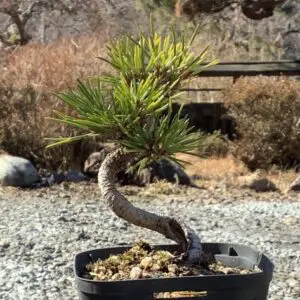The front side of a bonsai tree is the side that looks most aesthetically pleasing from the viewing angle. It is important to consider both visual appeal and visual interest when selecting the front of a bonsai tree, but it can change over time as the tree grows and matures.
What are the front and the back of a bonsai tree?
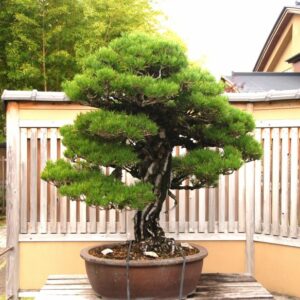
Front (Japanese black pine)

Back (Japanese black pine)
Bonsai is a Japanese art form that involves creating miniature versions of full-sized trees in a bonsai pot.
When displaying a bonsai, the position of the front of the tree is crucial to its overall appearance and aesthetic because the tree is typically viewed from one specific direction. The side of the tree that looks the most beautiful from the viewing angle is known as the “front” side, while the opposite side is considered the “back” side.
The front of a bonsai tree should be carefully chosen based on the tree’s most appealing visual aspects, including the surface roots, the shape and structure of the trunk, the positioning of the branches, and the arrangement of the foliage.
The bonsai should be planted in a way that allows all these elements to be appreciated by the viewers.
Choosing the right front enhances the overall aesthetic of the tree and brings out its unique features. A poorly chosen front can detract from the tree’s beauty and balance.
How to pick the front of a bonsai tree
What to consider when choosing the front
The front of a bonsai is an important consideration in bonsai styling as it is the angle from which the tree will be viewed and appreciated. There are 2 things to consider when choosing the front of a bonsai tree:
- Visual appeal
- Visual interest
Visual appeal
When viewing a tree growing naturally, the perception of its beauty can vary depending on the angle from which it is viewed. This is because the shape and structure of the tree can change dramatically based on its orientation and the arrangement of its branches and foliage.
This is also true when we view a bonsai tree. Depending on where we look from, it can be visually pleasing or boring/unattractive. This is why the selection of the front side of a bonsai tree is one of the most important design decisions.
The front side of the bonsai is the side that is most aesthetically pleasing when viewed from a particular angle. The selection of the front side is influenced by several factors, including the shape of the trunk, the orientation of the branches, the distribution of foliage, and the overall balance of the tree.
This is undoubtedly subjective but there are some techniques to find the right front of a bonsai tree that I am going to explain in the next section.
Visual interest
Visual interest is also an important factor to consider when determining the front of a bonsai. There are 2 factors that can make a bonsai tree visually interesting:
- Asymmetry
- Hide and reveal
Asymmetry
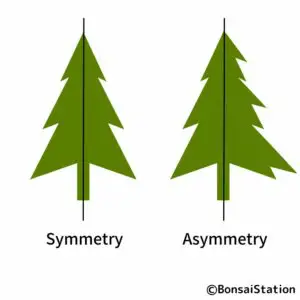
Asymmetry, by definition, lacks symmetry and is characterized by imbalance and disorder, creating a sense of tension and complexity that can evoke a range of emotions, including interest and curiosity. Asymmetry is common in natural forms and creates more active space and unpredictable patterns, drawing attention.
Symmetry, on the other hand, can be aesthetically pleasing and comforting but it may be too predictable and boring.
Hide and reveal
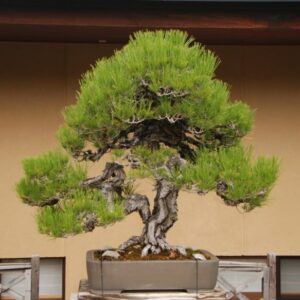
Creating a sense of depth and surprise through “hide and reveal” (Miegakure) is an important factor in bonsai styling. “Hide and reveal” refers to the technique of concealing or partially obscuring certain elements of a tree in order to create a sense of depth, mystery, and surprise.
If you can look every part of the tree at a glance, it is uninteresting because you do not have anything else to look for in a tree. In contrast, if a part of the trunk or branches is obscured in some way, it evokes mystery, creates viewers’ anticipation and fires their curiosity.
This hide-and-reveal can also create the illusion of distance and depth in a bonsai tree. Revealing everything can be monotonous and flat without depth.
Techniques for finding the front
There are several techniques that can help determine the best front for a bonsai tree.
Visual appeal

Nebari and Tachiagari
One of the bonsai tree’s most appealing visual aspects is the surface roots (Nebari) and the lowest part of the trunk (Tachiagari) because it dictates the sense of stability of the tree, making it appear as if it is grabbing the soil on the ground powerfully as an old tree.
Surface roots
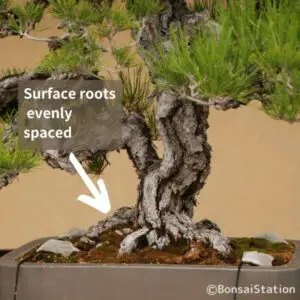
Surface roots evenly spaced
You should thus be looking for an angle where the surface roots are/look evenly spaced on the surface of the soil, entering the soil naturally to support the tree.
No visible scars
You should also be looking for an angle of the tree where no visible scars are seen on the trunk. Also, the lowerest part of the trunk should rise upward from the surface roots, gradually becoming thinner as it goes up.
Curve tilting toward the front
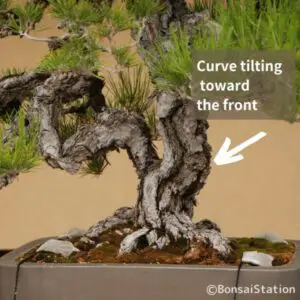
The curve tilting toward the front
If the trunk is curvy, look for an angle where the curve is coming toward the front. This will create a sense of grandeur and strength as well as depth.
Visual interest
Asymmetry
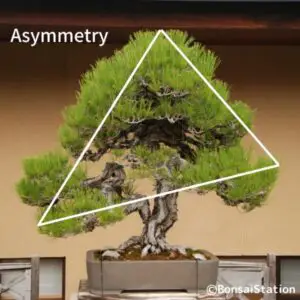
Asymmetry
When choosing the front of a bonsai tree, look for an angle where the whole tree is asymmetrical rather than symmetrical.
Hide and reveal
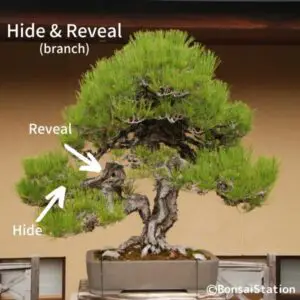
Hide and reveal
Also, look for an angle where you can see the structure of the tree but its elements such as the trunk, branches and foliage are partly concealed.
More branches at the back

Front: visible trunk

Back: more branches
At the back side of the bonsai tree, there should be more branches attached to it. This creates a sense of depth and visual interest when the tree is viewed from the front.
Experiment: finding the front of my Japanese black pine
To demonstrate how to find the front of a bonsai tree, let’s use my Japanese black pine (pre)bonsai tree as an example. I took several photos of the tree from different angles and evaluated each one according to the parameters I mentioned earlier.
Visual appeal
First, I looked for the side that had the most visual appeal.
As this tree’s trunk has several interesting curves, I was looking for the angle that the lowest part of the trunk (Tachiagari) had an elegant curve slightly coming toward me and led the eye upwards naturally onto the branches and foliage.
If you look at the picture where the curve at the Tachiagari is going away, you can see that it has less visual appeal as it lacks the power and intensity to please us.
At this angle, we can see a visible scar on the lowest part of the trunk and this side of the tree is not suitable for the front.
For the surface roots, I have to wait until I repot the tree in a few weeks.
Visual interest
Next, I searched for an angle that would make the tree more visually interesting.
I was looking for an angle where the tree’s structure was asymmetry with more branches and foliage on the back side, which adds its natural and organic look.
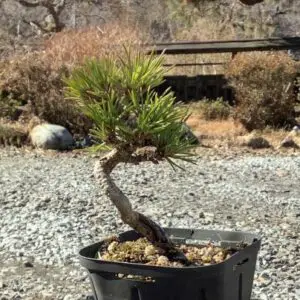
Angle not interesting enough
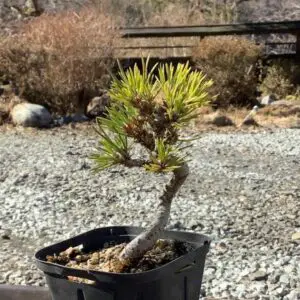
Angle not interesting enough
From these angles, the curves are not conspicuous and not interesting enough to watch.
Overall, by considering both the visual appeal and visual interest of the tree, I think I was able to find the best angle that showcased my Japanese black pine bonsai tree’s natural beauty and unique characteristics.
Can the front of a bonsai tree change over time?
While choosing the front for a bonsai tree is crucial, the decision is not permanent and the front of the tree can change over time as the tree grows and matures.
This change can be natural or deliberate depending on various factors including the tree’s growth habit, the development/styling of new branches, and changes happened/made in the tree’s balance and composition.
Factors that can affect the front
One of the most common reasons why the front of a bonsai tree can change over time is due to its growth habit. As the tree grows, it may develop new branches and foliage that create a more visually appealing composition from a different angle.
Also, the tree’s balance and overall composition can shift over time, making it more visually pleasing from a new front position.
Another factor that can affect the tree’s front position is your preferences. You may decide to change the front of the tree because another angle has a more visually appealing composition.
Is it okay to change the front of a bonsai tree?
Changing the front of a bonsai tree is not at all a bad thing and it is a common practice among bonsai growers.
As bonsai trees are living organisms, we cannot always force them to grow in a certain way that we want them to. We sometimes have to accept and embrace their change and act accordingly.
Make sure that the new front position is visually pleasing and well-balanced taking into account the tree’s natural growth habits.
The relationship between the front and bonsai health
The front of a bonsai tree is an essential aspect of its design. But the front is not just a design only because the decision can have an impact on the tree’s overall health and vitality.
The front and sunlight exposure

One of the most important factors to consider when you fix the front of a bonsai tree is sunlight exposure. As the front of a bonsai tree faces the viewers and it stays that way, one (or two) side(s) of the bonsai tree will receive more sunlight than the other sides, which will impact the tree’s growth.
Make sure to turn the tree facing the back to you or change the location of the tree from time to time so that all the sides of the tree receive an equal amount of sunlight.
The front and air circulation

Another factor to consider when you fix the front of a bonsai tree is air circulation. Depending on where you place your bonsai trees, some sides of the tree can get more air than others.
Proper air circulation is essential for the trees’ overall health and vitality as they need carbon dioxide for photosynthesis. Fresh air can also help prevent the growth of harmful fungi and other pathogens.
Make sure to turn the tree facing the back to you or change the location of the tree from time to time so that all the sides of the tree receive enough air circulation.




